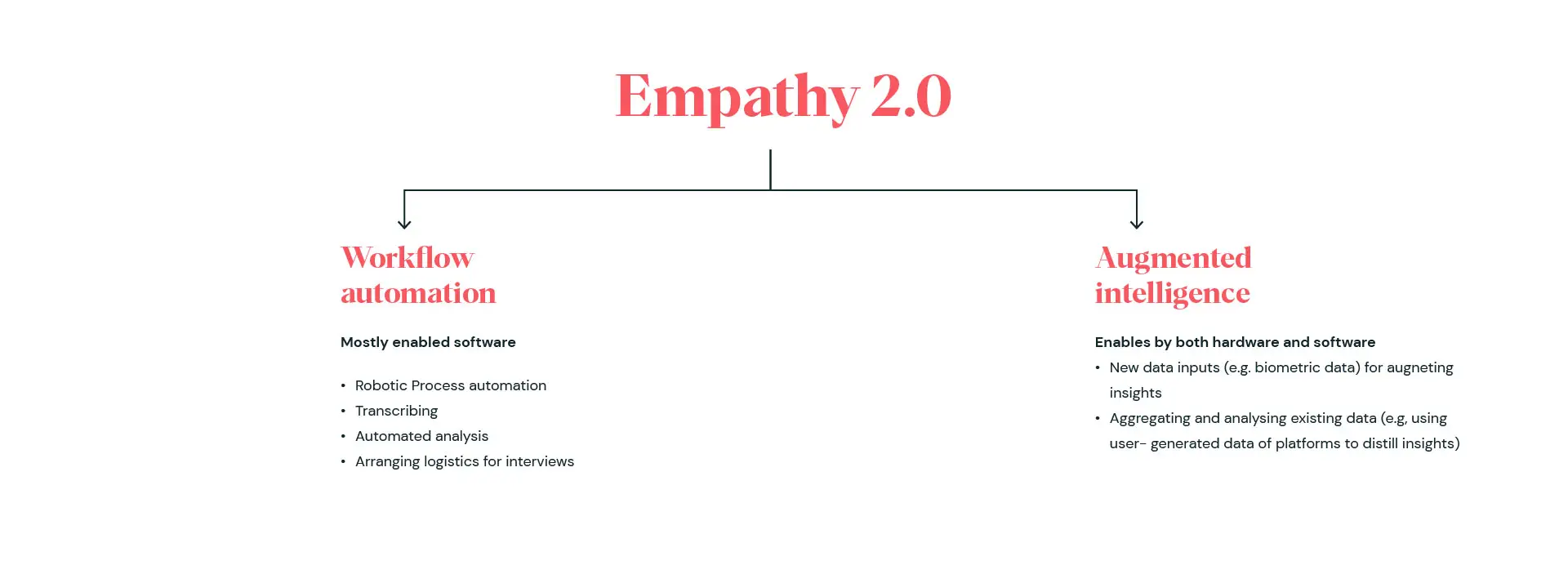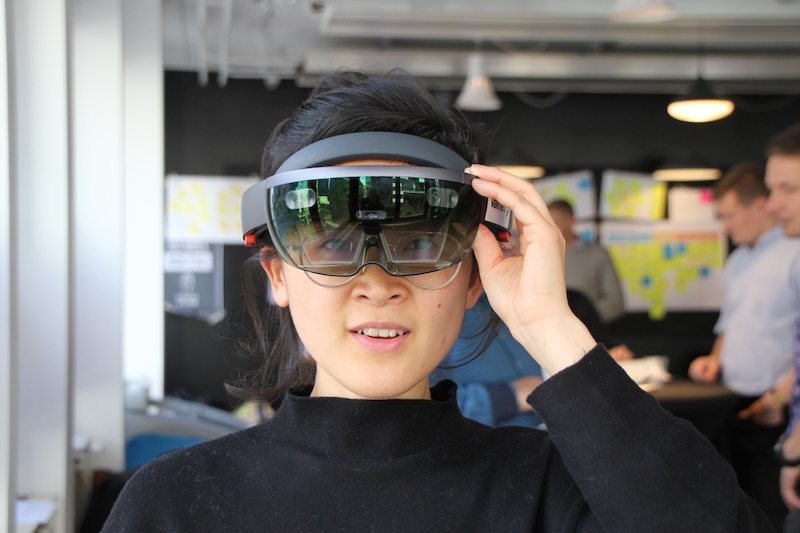Augmented intelligence—as a set of solutions to human problems, as a movement beyond its individual technologies—has been branded with many nicknames, the latest among them is the “age of empathy.” That moniker symbolizes both a technological problem and an innovation challenge: how to create AI capable of empathy and more human-like decision making, and how to use empathic AI to craft a stronger, smarter future that puts people’s interests first. We’re already seeing this technology emerge at the consumer level; it’s high time we look at how it can help us reduce risk, bring down costs and increase value.
To tackle the innovation challenge of empathy-capable AI, we need to dig into the details of the latest innovations that make use of that AI. One of the biggest technological challenges to securing adoption of AI technologies for workflow, customer experience and other arenas relates directly to empathy: improving human-machine interaction. Machine learning has already boosted capacity in business through vast data analysis and other quantitative forms of problem solving—now it’s changing workflow through tools like intelligent conversational interfaces (also known as chatbots), with each conversation increasing the technology’s capacity as well as users’ relationships to the technology.
New AI technologies have the potential to work hand in hand with humans to enable better workflow while also uncovering user insights. As companies begin to integrate human-centred design thinking into AI systems not only are those systems infused with empathy, but they can tackle the design-thinking problems of empathy. From a workflow perspective, that means they can streamline data-driven processes for understanding users and speed up design thinking’s role in innovation, which, by its human-focused nature, is time- and intellect-intensive. AI can charge up innovation by connecting dots we may not have seen, quickly leading to greater insights about customers’ needs, gaps in industries and inefficiencies in workflow. Here we’ll dive into the latest advances in AI-based technologies and explore their potential
How tech can supercharge design thinking

The state of AI for workflow automation
As state-of-the-art AI research technologies leave the lab and enter the business sphere as apps and other user-friendly products, we’re seeing the indispensable role they can play in more efficiently crafting user experience, doing interviews and research faster and solving other business problems related to workflow, scale and efficiency. While machine thinking has long dealt in data, it’s now capable of crunching the difficult, hard to categorize data of human emotion and experience. That’s important because when designing for innovation, we’re really designing for people.
For most people, everyday interactions with AI are still abstract and behind the scenes. New software with friendlier interfaces and targeted solutions bring AI’s data gathering and analysis power into almost all departments within an organization, providing speedily delivered results that make a measurable difference in strategic outcomes. When it comes to more tangible interactions with AI machines, including customer-facing interactions, artificial empathy makes all the difference. Still based in large quantities of data processing, these new technologies of emotional intelligence and empathy are on the rise—and their applications are multiplying.
TIPS: Use empathy-related AI tools to...
- Connect with more people in a shorter time: AI-enhanced chatbots, surveys and other forms of automated interaction are being designed with more personality and the ability to match users’ conversational styles. They’re able to more effectively communicate with users, solve problems faster or gather more accurate and useful information.
- Understand what motivates users’ choices: AI-powered qualitative data analysis can be automated to gather feedback directly from users through surveys, questionnaires, interviews, social media and online feedback sites. AI does the time-intensive data analysis to empower humans to discover often unexpected insights and act on them to craft UX strategy.
- Reduce research time and increase scope: Essentially, AI could help you learn more in less time. When an IDEO app development team added a bot to their daily routine, they were able to expand how much data they could gather and manage because the bot did it for them. With all that data, they were able to alter their prototype for a better user experience. Rather than hinting at a dystopian AI future, the bot empowered the team, rather than replacing them.
- Connect ideas like never before: Automating the design process delegates routine and mechanical tasks to AI so designers can focus on higher level design thinking. While qualitative data analytics brings together currently separate consumer and marketing data streams, leading to new insights that reach across departments and a faster route to idea optimization.
- Reduce or eliminate tedious and costly tasks: Robotic process automation isn’t new, but intelligent automation is rapidly transforming it, essentially taking the robot out of the human to detect behavior changes, recognize patterns and process unstructured data to save time and money in finance departments, marketing, customer service and payroll administration. Meanwhile, AI-powered transcription software lets people focus on insights, not notetaking by using voice recognition and analysis to vastly speed up transcription time and accuracy, turning audio and video into text for data analysis, further research and even SEO value.
Automate workflow with time-saving, accuracy-boosting tools
New AI data analytics technologies have already reached a cross-sector consumer level and in-person human-AI interactions are well on their way. With higher accuracy and analysis into what motivates users on emotional and rational levels, several new AI technologies stand out for their relevance to a range of business cases and innovation applications.
1. Increase scope and accuracy of empathy interviews
By nature, the design thinking approach to innovation and growth is time-intensive. When we’re reframing business problems in human-centric ways, it makes sense that we need to consult, meet and brainstorm with humans, and get hands-on with prototyping and testing new ideas. That all takes time and people.
AI technologies offer a data-analysis spin on the old web-based Mturk approach of dividing a large amount of work among hundreds of different people. With empathy-capable AI, could we do 100 empathy interviews in an hour or ask a wider array of questions? Even more relevant to today’s AI technology capabilities: how do we capture as much data and as many insights as possible through those interviews? Among some of the current AI solutions:
- Predict and automate responses: Running with the statistic that 80% of visitors who engage in live chat are more likely to become customers, analytics-based solution HumanFirst engages people through chat, optimizing conversations that result in strong conversation-through rates and growth.
- Scale customer interactions: Roof virtual assistant scales customer interactions without cutting out the human interviewer, but does automate the technical work of building and maintaining the relationship with customers. Made for the real estate market initially, the app detects buyers’ preferences and personalizes the experience, then captures, qualifies and routes leads to the best available agent via web chat.
- Fast and accurate transcription: Trint and other AI-powered transcription of audio and video can be taught custom words, transcribe quickly and make identifying meaningful information faster in instances when a human interviewer is absolutely necessary for the job.
2. Automate user interviews at scale
Face-to-face empathy interviews generate great qualitative data on users, but take a lot of time and money to plan and execute, especially if they require the interviewer to travel. AI automation doesn’t yet have the capacity of a focused, engaged and empathic moderator who is able to connect human-to-human and build trust. But it’s getting there.
AI can identify possible target audiences through feedback analysis, find contact information, craft an interview script based on the data and process the interview after it’s complete. Even now, AI’s mass qualitative data analysis saves time and money while still encouraging lateral thinking that leads to deeper insights. Try interviewing with:
- AI-enabled chatbots: Customer service is diving into AI-enabled machines made to learn on the job and get better at answering more complicated questions. For user experience interviews, if you begin with a defined market segment based on research and strategy, AI-enabled chatbots like Bold360’s and Wizu’s can collect qualitative data at scale, discover gaps in the market and even replace surveys. The more human-like chatbots become, with fluid interactions and the ability to anticipate where a conversation might lead, the more satisfied customers will be.
- Avatar systems: Ever more realistic virtual avatar systems, like SoulMachines, start out asking simple problems and solutions, improving their own programming as they move on to more complex and emotional issues. The results of interviews with a virtual avatar have the potential to be more accurate regardless of how emotional the interviewee is, as recently shown in research on eyewitness testimony and in medical training system MPathic-VR.
3. Automate qualitative data analysis for effective ux strategy
Several new AI companies specialize in automated analysis of qualitative user feedback and other information gathered through various digital sources. Even with AI doing the heavy data lifting and laying out paths to insights, humans are still integral to making meaning from those insights and exploring their applications. Save time and get to insights faster by using:
- AI text analytics software: Keatext and Wootric CXInsight provide a clearer picture on large amounts of unstructured customer feedback from a combination of review websites, customer surveys, NPS Scores and other information. That quick analysis leads to faster insights for how to enhance customer experience and create meaningful relationships.
- Data science focused on empathy: Signify features products that use machine learning and open source data sets to determine what users and customers care most about, increasing workplace “social empathy” through AI so clients can build campaigns, products and policies around users’ desires.
4. Increase capacity for evidence-based and outside-the-box thinking
Research, whether combing through texts or talking with users, is time-intensive and requires the kind of categorizing and pattern recognition that AI is made for. Research-oriented AI software connects the dots when you don’t have the time or the capacity to do so, and can:
- Enhance creative thinking: Klydo scouts the web based on criteria you provide and filters research together to connect dots that you can’t even see. In that way, it creates context for your problem (with visuals to match), and gives you more light-bulb moments.
- Tackle interdisciplinary projects: Iris.ai research assistant tools combine knowledge from a range of fields to speed up the research process.
- Test marketing messaging: Tanjo Animated Personas app tests marketing and product messaging and other concepts as if it is a simulated customer, learning and evolving over time, using empathy to connect product and service creators with customers they might never get a chance to meet.
Time to move into the future of empathy with AI
One of the biggest variables in design thinking for innovation is empathy: what people look for in a product or service and how people make choices is as complex and unique as each individual. With billions of people in the world, that’s a lot of data. AI solutions for empathy are all about making sense of that data so you can use it wisely: to direct your teams’ time and budgets towards innovative and growth-oriented solutions, to understand your customers better and to inspire new ideas within your company.
Board of Innovation is always on the lookout for innovative solutions that drive growth and open new avenues for businesses, whether AI-powered or otherwise. Visit our Innovation Stack page to find some of the most effective digital tools for your innovation process. And if you see we’re missing a tool, let us know! We collect this information for our InnoTech workshops and our Projects with Tech Lab – another way we’re looking at the future of business.

Discover our Tech lab
We use the latest technology to test innovation methods to help corporations build new businesses.


